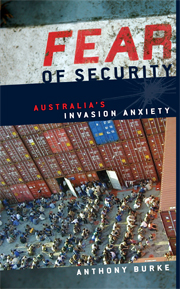Book contents
- Frontmatter
- Contents
- Preface and acknowledgements
- Abbreviations
- Introduction
- 1 Securing the Australian subject 1788–1918
- 2 Dreams of Pacific security 1919–45
- 3 Cold War against the Other 1946–69
- 4 Realpolitik beyond the Cold War 1970–95
- 5 Australia's Asian crisis 1996–2000
- 6 The wages of terror 2001–07
- Conclusion: A cosmopolitan future
- Notes
- Index
2 - Dreams of Pacific security 1919–45
Published online by Cambridge University Press: 03 May 2010
- Frontmatter
- Contents
- Preface and acknowledgements
- Abbreviations
- Introduction
- 1 Securing the Australian subject 1788–1918
- 2 Dreams of Pacific security 1919–45
- 3 Cold War against the Other 1946–69
- 4 Realpolitik beyond the Cold War 1970–95
- 5 Australia's Asian crisis 1996–2000
- 6 The wages of terror 2001–07
- Conclusion: A cosmopolitan future
- Notes
- Index
Summary
Have those who think Australia remote from the world which hatches dangers and wars ever looked at the map? … So far from being removed from the busy hive of men we live almost within hail of its greatest populations. We have nailed ‘White Australia’ to the top of the mast. Yet we are but a tiny drop in a coloured ocean.
W. M. Hughes, 14 August 1916At the close of the Great War a powerful myth of Australian character and realisation had been achieved, at the price of tens of thousands of lives and unprecedented upheaval and division. In addition, ‘Australia’ had new international status – not as a ‘great power’ but as an internationally recognised subject whose claims on Pacific territory and international norms would demand, and find, a hearing. The Anzac tradition was already at work: when his status was challenged by Woodrow Wilson at Versailles, Hughes replied that he spoke for 60 000 dead. Were they to see this moment, they would learn that they had endured the cold and filth of the trenches, the lice and poison gas, thrown their bodies before machine-gun fire and shrapnel until they were stopped, so that the old things could continue: a white Australia, a defensive buffer of Pacific territory, the ‘crimson thread of kinship’. The diggers' sacrifices won Australia independent representation at the peace conference and Hughes much influence within the British delegation.
- Type
- Chapter
- Information
- Fear of SecurityAustralia's Invasion Anxiety, pp. 51 - 82Publisher: Cambridge University PressPrint publication year: 2008



